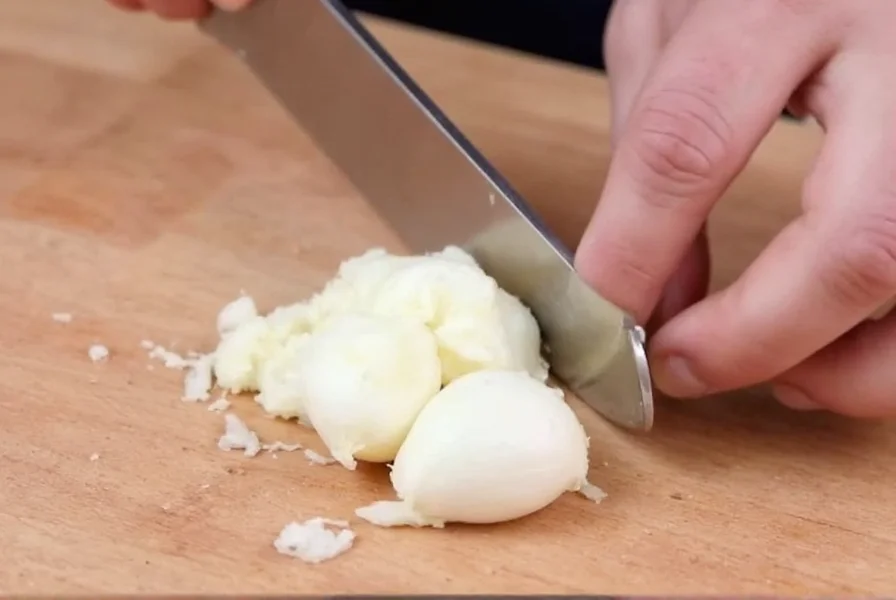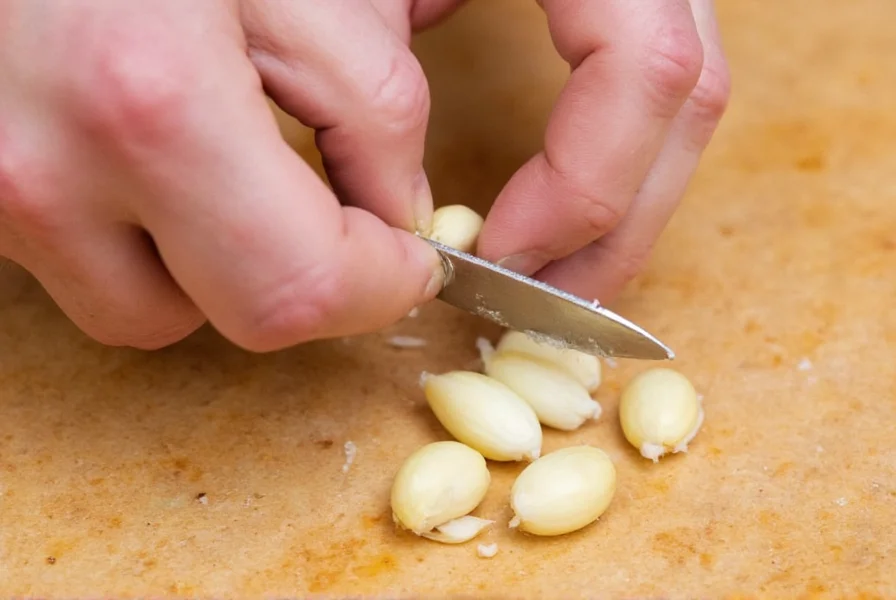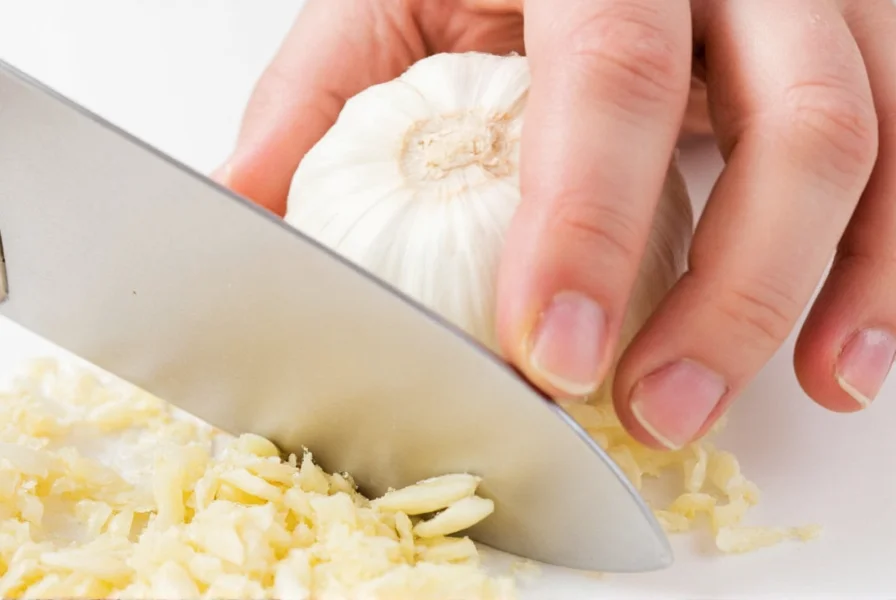Properly minced garlic transforms ordinary dishes into culinary masterpieces, but many home cooks struggle with uneven pieces, sticky messes, or bitter flavors from improper technique. Getting the mince right affects both texture and flavor distribution in your cooking—too coarse and you'll get overwhelming garlic bites; too fine and you risk burning during cooking. The ideal minced garlic should resemble coarse sand with uniform pieces no larger than 1/16 inch.
Essential Tools for Mincing Garlic
While a sharp chef's knife remains the most versatile tool for mincing garlic, several alternatives work well depending on your needs and kitchen setup. Understanding each option helps you choose the best method for your situation.
| Tool | Best For | Texture Result | Time Required |
|---|---|---|---|
| Chef's knife | Most cooking applications | Uniform, slightly textured | 45-60 seconds |
| Garlic press | Quick sauces and dressings | Very fine, almost paste-like | 20-30 seconds |
| Microplane grater | Delicate dishes and marinades | Ultra-fine, almost liquid | 30-45 seconds |
| Food processor | Large quantities | Can become mushy if over-processed | 2-3 minutes |
Step-by-Step: Perfect Knife Mincing Technique
Mastering the knife method gives you complete control over texture and prevents the bitter compounds that develop when garlic is crushed too aggressively. This professional technique works for any quantity of garlic.
- Prepare the clove: Place the garlic clove on your cutting board and press down firmly with the flat side of your knife to loosen the skin. Remove the papery skin and trim any hard root end.
- Create thin slices: Hold the clove flat-side down and make thin lengthwise slices without cutting all the way through the base. This creates a fan of garlic slices still connected at one end.
- Turn and slice: Rotate the garlic 90 degrees and make crosswise slices to create small pieces.
- Rock the knife: Gather the pieces under your knife blade, place your free hand on the spine of the knife, and rock the blade back and forth while applying gentle pressure. Periodically scrape the garlic together and repeat.
- Check consistency: Stop when pieces reach the size of coarse sand (about 1/16 inch). Over-mincing releases bitter compounds.

Alternative Mincing Methods
When a knife isn't practical or you need different textures, these alternative approaches deliver excellent results for specific applications.
Garlic Press Method
For quick sauces or dressings where ultra-fine texture is preferred, a garlic press works efficiently. First remove the skin, then place the clove in the press chamber. Apply steady pressure—don't hammer—to extract the minced garlic. Immediately rinse the press to prevent garlic from drying in the holes. This method produces a paste-like consistency that incorporates quickly into liquids but can become bitter if cooked too long.
Microplane Grating Technique
For delicate dishes like aioli or vinaigrettes where you want garlic flavor without texture, a microplane grater creates almost liquid garlic. After peeling, hold the grater at a 45-degree angle over your bowl and gently drag the garlic clove downward. This method extracts maximum flavor compounds with minimal fiber, but the resulting garlic burns extremely quickly during cooking.

Professional Tips for Perfect Garlic Mince
Seasoned chefs employ these techniques to maximize flavor and minimize frustration when working with garlic:
- Prevent sticking: Sprinkle a pinch of coarse salt over the garlic before mincing—the salt acts as an abrasive that helps break down the garlic while preventing sticking to your knife.
- Measure accurately: One medium garlic clove yields approximately 1½ teaspoons of minced garlic. For precise recipes, use this conversion: 3-4 average cloves = 1 tablespoon minced garlic.
- Avoid bitterness: Never use a food processor for small quantities—the sharp blades over-process garlic, releasing allicin compounds that turn bitter within minutes.
- Preserve freshness: If preparing garlic in advance, mix with a teaspoon of olive oil to prevent oxidation and flavor degradation. Store in an airtight container for up to 24 hours.
Common Garlic Mincing Mistakes to Avoid
Even experienced cooks sometimes fall into these traps that compromise garlic flavor and texture:
- Using a dull knife: Dull blades crush rather than cut garlic, releasing excessive enzymes that create bitter flavors. Always use a sharp chef's knife for clean cuts.
- Over-mincing: Continuing to chop after reaching proper consistency creates garlic paste that burns easily and develops harsh flavors.
- Skipping the rest period: Let minced garlic sit for 10-15 minutes before cooking to allow flavor compounds to develop fully—this maximizes both aroma and health benefits.
- Adding to hot oil immediately: Always add minced garlic to warm (not smoking hot) oil to prevent burning, which creates acrid, unpleasant flavors.
FAQ
How fine should properly minced garlic be?
Properly minced garlic should resemble coarse sand with uniform pieces no larger than 1/16 inch. You should be able to easily pick up a pinch between two fingers without large chunks separating. This size ensures even flavor distribution without overwhelming bites of raw garlic in your finished dish.
Can I mince garlic without a knife?
Yes, you can mince garlic without a knife using alternative methods. A garlic press produces fine mince quickly but can create bitterness if over-processed. A microplane grater creates ultra-fine garlic ideal for dressings. For emergency situations, place peeled garlic in a sealed plastic bag with a pinch of salt and crush with a rolling pin or heavy pan. Each method yields different textures suitable for specific applications.
Why does my minced garlic stick to the knife?
Garlic sticks to knives due to its natural moisture and sticky compounds. To prevent this, ensure your knife is extremely sharp (dull blades create more surface area for sticking), sprinkle a pinch of coarse salt over the garlic before mincing, or lightly oil your knife blade. Professional chefs often use the salt trick—it acts as an abrasive that helps break down garlic while preventing adhesion to the blade.
How much minced garlic equals one clove?
One average-sized garlic clove yields approximately 1½ teaspoons of minced garlic. For precise measurements: 3-4 medium cloves equal 1 tablespoon of minced garlic. When substituting jarred minced garlic, use ½ teaspoon per clove as commercial products often contain preservatives that alter concentration. Always adjust based on garlic variety and personal taste preferences.
Should I wash minced garlic to remove bitterness?
No, washing minced garlic removes valuable flavor compounds along with potential bitterness. Instead, prevent bitterness by using a sharp knife, avoiding over-mincing, and letting minced garlic rest 10-15 minutes before cooking. If bitterness occurs, balance it with a pinch of sugar or acid like lemon juice in your recipe. Washing garlic dilutes flavor and creates moisture that causes splattering when added to hot oil.











 浙公网安备
33010002000092号
浙公网安备
33010002000092号 浙B2-20120091-4
浙B2-20120091-4